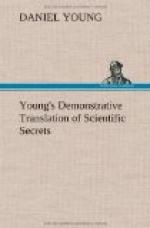3. Transfer varnish
Take of Canada balsam 3 drachms; gum sandric 3 drachms; spirits of wine 1/2 pint. Dissolve the balsam and gum in the spirits of wine and it is ready for use.
4. White spirit varnish—the very best.
Take of gum sandrack 4 ounces; mastic 1 ounce; Elmi rosin 1/2 ounce; Venice turpentine 1 ounce; alcohol 15 ounces. Digest in a bottle, frequently shaking, till the gums are dissolved, and it is ready for use.
5. Transfer painting on wood
By this you may transfer any picture you please from paper to a cutter back, or any other substance you please. Give the board three coats of white spirit varnish, receipt No. 4; damp the back of the print with strong vinegar; give the front a very heavy coat of the transfer varnish, receipt No. 3; then press it on the board, avoiding creases; when perfectly dry and fast, rub the paper away; the print is indelibly fixed; then varnish it over as you would any other painting. This receipt has been commonly sold for $5.
6. Electro gold plating—new method
Take 100 grams of laminated gold, mixed with 20 grams of hydrochloric acid; 10 grams of nitric acid; the liquid thus composed is placed over a moderate fire, and stirred constantly until the gold passes into the state of chlorine; it is then allowed to cool. A second liquid is formed by dissolving 60 grams of cyanide of potassium in 80 grams of distilled waters; the two liquids are mixed together in a decanter and stirred for 20 minutes, and then filtered. Finally 100 grams of whiting, dry and sifted, are mixed with 5 grams of pulverised supertartrate of potass; this new powder is dissolved in a portion of the above described liquid, in sufficient quantity to form a paste of the proper consistency to be spread with a pencil on the article or part to be gilded. The superabundant powder is then removed by washing and the article is beautifully gilded with a heavy or light coat, according to the quantity of paste used. Grams belong to French weights, four grams are a little more than one drachm.
7. Electro silvering—new method
10 grams of nitrate of silver are dissolved in 50 grams of distilled water; then 25 grams of cyanide of potassium in 50 grams of distilled water; the two liquids are mixed in a decanter, and stirred for 10 minutes; it is then filtered. Finally, 100 grams of sifted whiting are mixed with 10 grams of pulverised supertartrate of potass and one gram of mercury. This powder and dissolving liquid are used in the same manner as in the above method of gold plating. These excellent methods of silvering and gilding were discovered in June 1860, by the great French chemist Baldooshong of Paris France. It is far superior to any other method ever discovered, and will eventually take the place of all.




